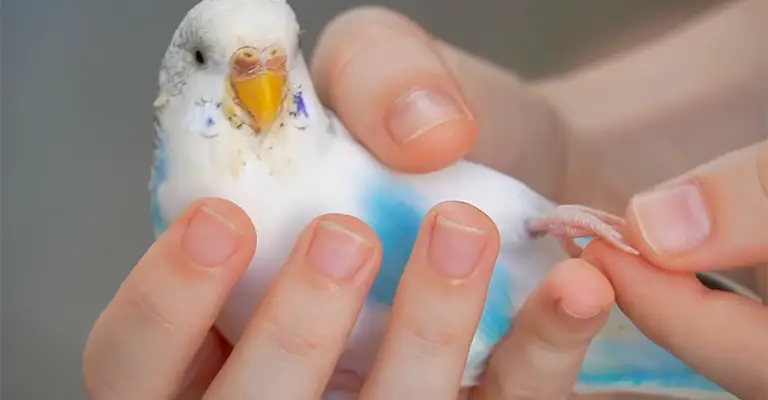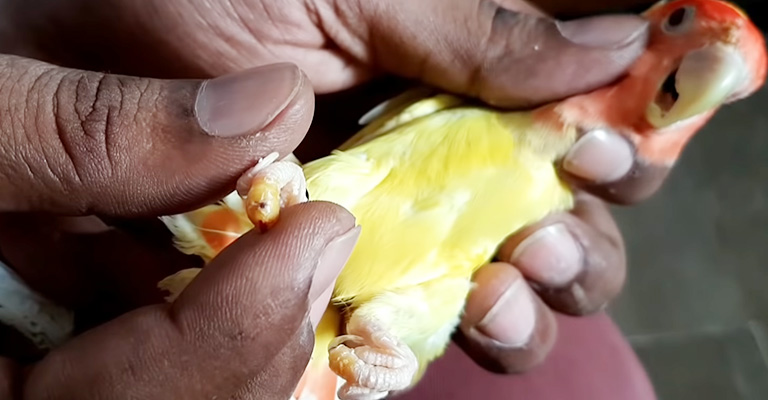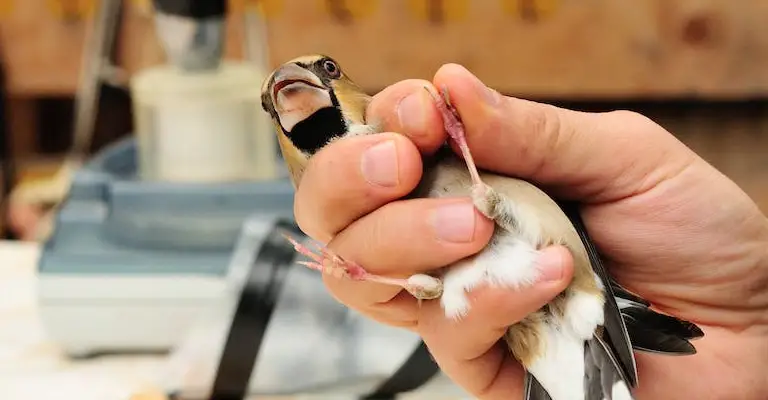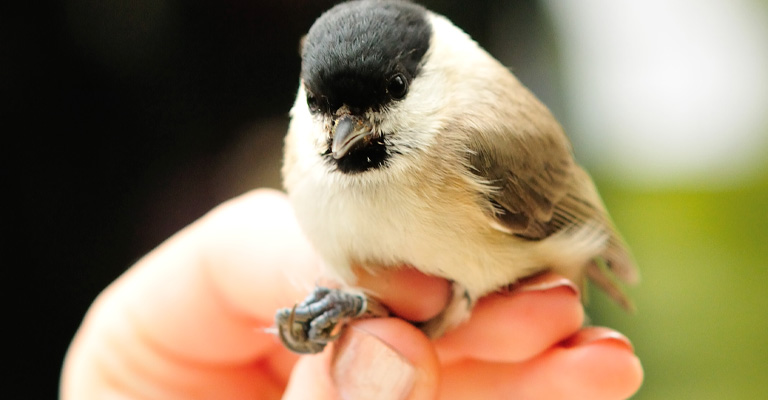Sometimes, we find our birds, not putting weight on its foot. It’s important to be attentive to changes in your feathered friend’s behavior and physical condition, as they may indicate underlying health concerns.
When a bird refuses to put weight on one of its feet, it can be a sign of various causes. One possibility is a foot or leg injury resulting from a fall or an accident.
Usually, birds are active creatures and accidents can happen, just like with any other pet. Another potential cause is arthritis, which can affect birds, especially as they age.
However, to learn the entire fact, we need an in-depth discussion. Let’s then start it.

Causes of a Bird Not Putting Weight on Its Foot
There can be different reasons a bird may not put weight on its foot. Here are the possible common reasons that mainly bother your bird.
Injury
Birds may experience injuries that lead to a reluctance to put weight on their feet, including fractures, sprains, dislocations, and lacerations.
These injuries can result from various circumstances like falling from a height, being stepped on, or getting their feet caught. Inadequate perching or roosting areas and a lack of appropriate foot toys can also contribute to such injuries.
Infection

Bumblefoot and fungus are common infections that can cause birds to avoid putting weight on their feet.
Bumblefoot is a bacterial infection caused by staphylococcus bacteria, resulting in swollen, red, and painful feet with visible scabs.
Dirty or wet perches, poor diet, and a weakened immune system contribute to bumblefoot. Fungus infections can arise from a weak immune system, poor hygiene, or exposure to contaminated surfaces, leading to foot discoloration, scaling, or cracking.
Tumors
Tumors that can develop on a bird’s foot include sarcomas and carcinomas. Symptoms of such tumors may include the presence of a lump or mass on the foot, swelling, and difficulty in putting weight on the affected foot. Prompt veterinary evaluation is essential for the proper diagnosis and treatment of these conditions.
Diseases
Gout and arthritis are common diseases that can impact a bird’s feet and joints. Gout involves the accumulation of uric acid crystals in joints, while arthritis causes joint inflammation.
Symptoms of gout include swelling and limited movement, while arthritis manifests as stiffness, swelling, and pain.
These conditions can stem from factors like diet, exercise, or genetics. It’s advisable to consult a veterinarian to accurately diagnose any foot-related issues in birds and determine the appropriate treatment.
Symptoms of a Bird Not Putting Weight on Its Foot

Now, you must be thinking about what are the common symptoms that are related to the bird’s behavior of not putting weight on its foot. Well, the list of symptoms is right below.
Limping or Favoring One Foot
This is one of the most obvious symptoms of a bird not putting weight on its foot. If a bird is limping or favoring one foot, it means that it is experiencing pain or discomfort in the affected foot and is avoiding putting weight on it. This can be seen as a limp, or as the bird holding its leg up off the ground while standing or walking.
Swelling or Redness in the Affected Foot
Swelling or redness in the affected foot can be an indication of an injury, infection, or inflammation. Swelling may be accompanied by heat or warmth in the affected area. It can also be a sign of a tumor or a cyst.
Decrease in Activity or Mobility
A bird that is not putting weight on its foot may also show a decrease in activity or mobility. This can include not wanting to move around as much, not being as playful, or even being reluctant to move at all.
This can be due to the pain or discomfort caused by the injury, infection, or disease. Birds with foot problems may also be less willing to perch or climb.
It’s important to keep an eye on your bird’s activity level and mobility, as well as its overall behavior, as changes in these areas can indicate a problem with the foot.
If you notice any of these symptoms, it’s recommended to take your bird to a veterinarian for an examination.
Diagnosis of This Problem

Let’s now talk about the process of diagnosing a bird that usually doesn’t put weight on its foot.
Physical Examination
A veterinarian will perform a physical examination on the bird to assess the affected foot. The examination will include a visual inspection of the foot, as well as palpation to check for any swelling, redness, or pain.
The vet may also check the foot’s range of motion and reflexes. The vet may also check the rest of the bird’s body to rule out any other possible causes of the problem.
Imaging tests (X-rays, etc.):
Imaging tests such as X-rays or ultrasounds may be used to help determine the cause of the problem. X-rays can help identify any bone fractures or tumors, while ultrasound can be used to check for soft tissue injuries or infections.
Importance of seeking veterinary care:
Seeking veterinary care is important when a bird is not putting weight on its foot. The veterinarian will be able to determine the cause of the problem and recommend the appropriate treatment.
Without proper diagnosis and treatment, the bird’s condition may worsen, and it may develop more severe complications, such as infection or even the loss of the foot.
Additionally, early diagnosis and treatment can help prevent permanent damage and improve the chances of a successful recovery.
It’s crucial to take your bird to a veterinarian with experience in avian medicine to ensure proper diagnosis and treatment.
Some birds may have multiple issues that need to be addressed, and a veterinarian experienced with birds can give you the best advice on how to help your feathered friend.
Treatment

There are some tips on treatment that often work. I think you should have learned about them as well.
Rest and Physical Therapy (for Injuries)
If the cause of the problem is an injury, the bird will typically need to rest and be given physical therapy to help it heal.
Rest may involve keeping the bird in a smaller area, such as a cage, to prevent it from moving around too much.
Physical therapy may include exercises to help improve the range of motion in the affected foot, as well as massages to help reduce swelling and inflammation.
Antibiotics and a Clean Environment (for Infections)
If the cause of the problem is an infection, the bird will typically be given antibiotics to help clear up the infection. It’s important to keep the bird’s environment clean to prevent re-infection.
This may include cleaning and disinfecting the bird’s cage and perches, as well as providing fresh water and food.
Surgery (for Tumors)
If the cause of the problem is a tumor, surgery may be necessary to remove it. Surgery for birds is a delicate procedure that should be done by an experienced avian veterinarian.
The bird will typically need to rest and recover after surgery and may need physical therapy to help it regain the use of its foot.
Special Diet or Medication (for Diseases)
If the cause of the problem is a disease such as gout or arthritis, the bird will typically be put on a special diet or medication to help manage the condition.
A special diet may include foods that are low in purines, which can help reduce the buildup of uric acid crystals in the joints. Medication may include anti-inflammatory drugs or other medications to help reduce pain and inflammation.
It’s important to follow the veterinarian’s instructions and advice on how to care for your bird during recovery.
This can include things like providing a specific diet, administering medication, or providing a specific type of physical therapy. Following the veterinarian’s advice will help to ensure that your bird recovers as quickly and fully as possible.
FAQs
Birds are unable to grow back a lost foot. If a bird loses a foot due to injury or disease, it will have to learn to adapt to living without it. However, some birds can still lead normal and healthy lives with the proper care and accommodations.
It is not normal for birds to lose their feet. Foot loss is typically the result of a serious underlying problem such as injury, infection, or disease. It’s important to address these issues promptly to prevent further complications.
There is no guaranteed way to prevent a bird from losing its foot, but there are things you can do to reduce the risk. This includes providing a clean and safe environment, providing appropriate foot toys and perches, and regularly taking your bird to the vet for check-ups.
Birds can learn to walk on one foot, but it can be more challenging for them. Birds are able to balance on one foot but they may have trouble getting around. Birds that have lost a foot may need special accommodations such as a steeper ramp or a smaller cage to help them move around more easily.
A bird’s diet can play a role in the health of their feet. Deficiencies in certain vitamins and minerals can lead to weak bones and joints, which can make a bird more prone to foot injuries. Additionally, a diet too high in purines can cause gout. A balanced diet and proper nutrition are crucial for the overall health of your pet bird.
Final Thought
Bird not putting weight on one of its feet is a significant issue that necessitates prompt attention and veterinary care.
It can be caused by various factors, including injuries, infections, tumors, or diseases. Recognizing symptoms such as limping, swelling, or decreased activity is crucial for early diagnosis and treatment, which can prevent long-term damage and promote a successful recovery.
Alongside professional care, providing a nutritious diet, a clean environment, and appropriate foot toys and perches is vital for maintaining overall foot health in pet birds.
Regular check-ups with an avian veterinarian further ensure the well-being of your feathered companion. By being attentive and proactive, you can ensure a happy and healthy life for your beloved bird.
Best of luck with your bird and hope that you’ve found your answer. Thank you.